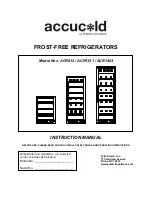
14
GE
MY20
IT
2020-02
428001235037
Use and maintenance manual
9.
RESIDUAL RISKS
During design the manufacturer examined all the areas or parts at risk.Therefore, all necessary precautions have been taken to
prevent risks to persons and damage to the appliance.
ATTENTION
Periodically check that all safety devices are operating correctly.
Do not remove the fixed guards.
Do not introduce unauthorised objects or tools into the work area.
Although the appliance is fitted with the safety devices prepared, there are still some risks that cannot be eliminated, but
reduced via corrective actions by the final integrator and correct operational procedures. Below is a summary of the remaining
risks associated with the appliance during:
Normal operation.
Adjustments and fine-tuning.
Maintenance.
Cleaning.
9.1
RISK OF CONTACT WITH LIVE PARTS
Risk of breaking or damaging the electrical components of the appliance, with a possible reduction in safety levels following a short circuit.
Before connecting the electricity supply, make sure there is no ongoing maintenance work.
ATTENTION
Before carrying out the connection, check that the d.c. current in the installation point does not exceed the value indi-
cated on the protections switches present in the electric control board. If this is not the case, the user must provide the
relevant limiting devices.
It is strictly forbidden to conduct any electrical modification, in order to prevent additional unforeseen hazards and risks.
9.2
FIRE
DANGER
In the event of a fire, immediately disconnect the master switch from the main power supply line.
9.3
EXPLOSIVE ATMOSPHERE
The equipment must not be located in an area classified as an explosion risk according to 1999/92/EC such as:
Zone 0
An area in which there is a permanent, long-lasting or frequently explosive atmosphere made up of a mixture of air and
flammable substances in the form of gases, fumes or steam.
Zone 1
An area in which the formation of an explosive atmosphere, made up of a mixture of air and flammable substances in the form
of gases, fumes or steam is occasionally probable during normal activities.
Zone 20
An area in which there is a permanent, long-lasting or frequently explosive atmosphere in the form of clouds of combustible
dust in the air.
Zone 21
An area in which the formation of an explosive atmosphere in the form of clouds of combustible dust is occasionally probable
during normal activities.
9.4
SLIPPING
DANGER
Any leaks in the areas surrounding the appliance may cause personnel to slip. Check that there are no leaks and
keep these areas clean at all times.
9.5
TRIPPING
DANGER
Generally, untidy deposits of material may constitute a tripping hazard and a total or partial obstruction of
emergency exit routes. Ensure operational, transit and escape routes, free from obstacles, and comply with the
current regulations.















































